Menus
- Unrestored original team
- Could be ordered from the factory with a sidecar
- Spacious touring sidecar on the Victoria KR 6
- Victoria suspension fork reliable and comfortable
- Technical specifications
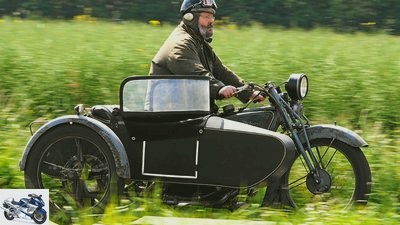
Siemer
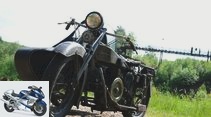
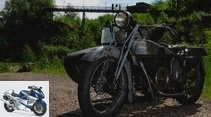
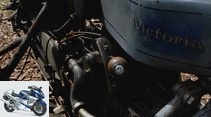
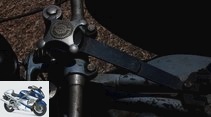
30th photos
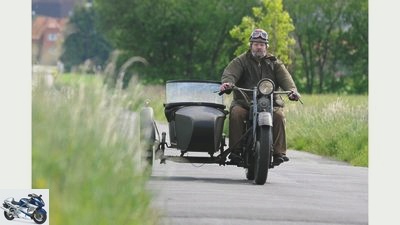
Siemer
1/30
Victoria KR 6 team.
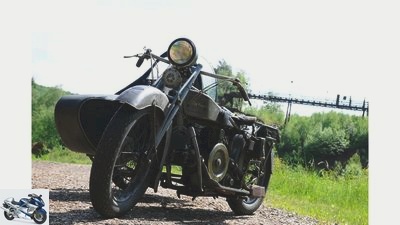
Siemer
2/30
Victoria KR 6 team.
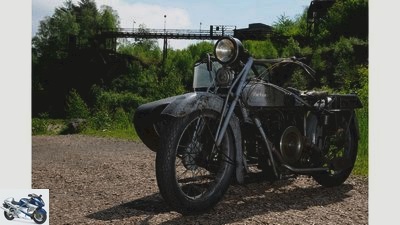
Siemer
3/30
Victoria KR 6 team.
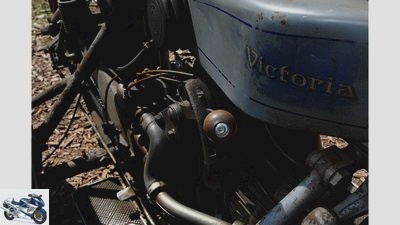
Siemer
4/30
Victoria KR 6 team.
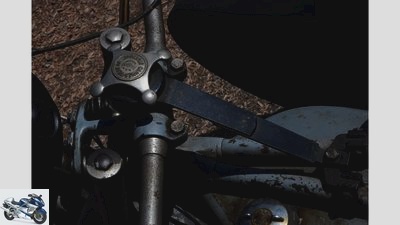
Siemer
5/30
Victoria KR 6 team.
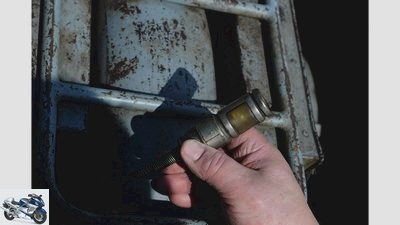
Siemer
6/30
Victoria KR 6 team.

Siemer
7/30
Victoria KR 6 team.
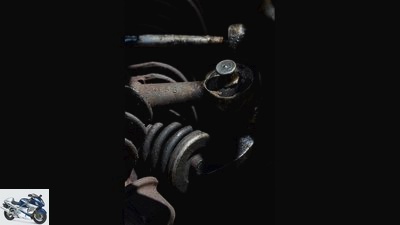
Siemer
8/30
Victoria KR 6 team.

Siemer
9/30
Victoria KR 6 team.
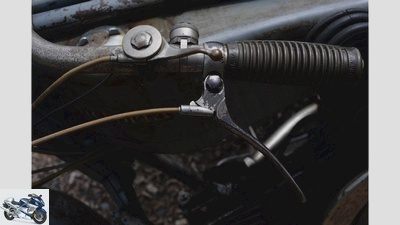
Siemer
10/30
Victoria KR 6 team.
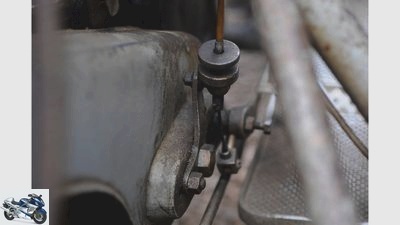
Siemer
11/30
Victoria KR 6 team.
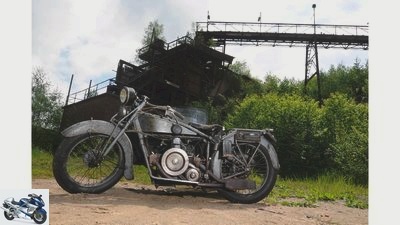
Siemer
12/30
Victoria KR 6 team.
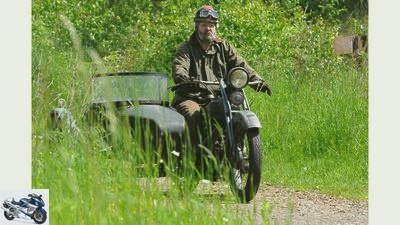
Siemer
13/30
Victoria KR 6 team.
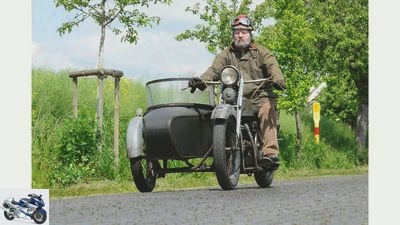
Siemer
14/30
Victoria KR 6 team.
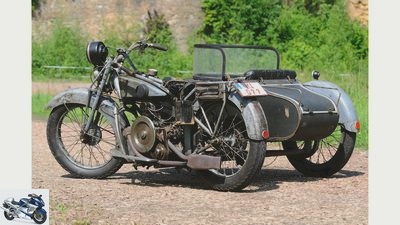
Siemer
15/30
Victoria KR 6 team.
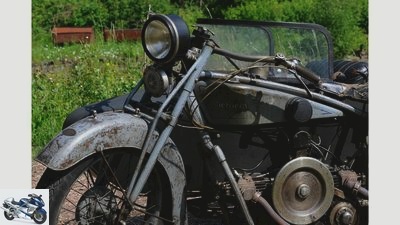
Siemer
16/30
Victoria KR 6 team.

Siemer
17/30
A motorbike that has aged in honor and therefore clearly taken along with you does not meet with the understanding it deserves.
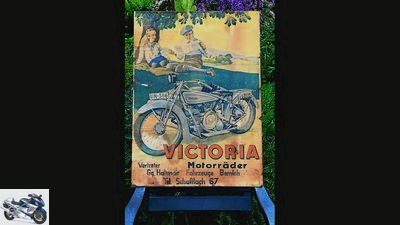
Siemer
18/30
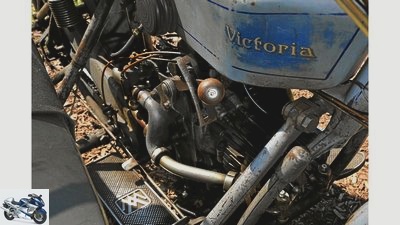
Siemer
19/30
Underneath the carburetor is the clutch pedal, which can also be operated by hand.
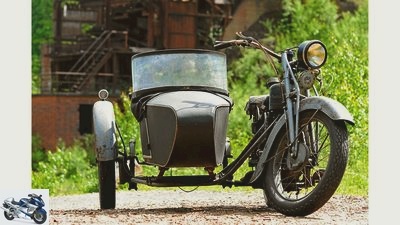
Siemer
20/30
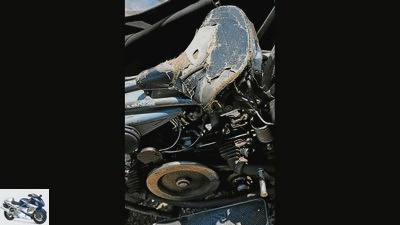
Siemer
21/30
A saddle like a novel: What has to happen to make leather so tattered??
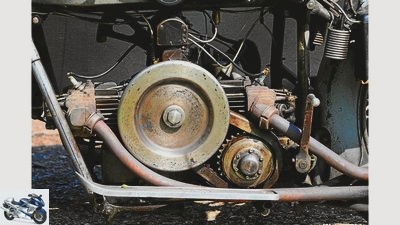
Siemer
22/30
Open flywheel and only rudimentarily encapsulated primary drive chain characterize the left side of the engine.
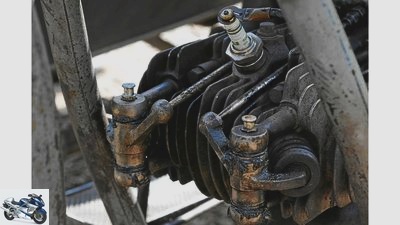
Siemer
23/30
The grease gun has to be used to lubricate the rocker arms on their shafts – and creates picturesque decorations.
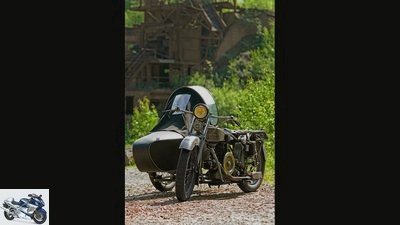
Siemer
24/30
Such a scratched bike can tell. What? Everyone is allowed to think up themselves.
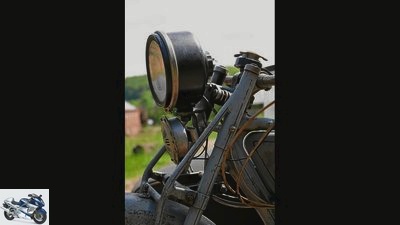
Siemer
25/30
In the bars of the unique Victoria fork, which was developed in-house, there is a tension spring and a compression spring.
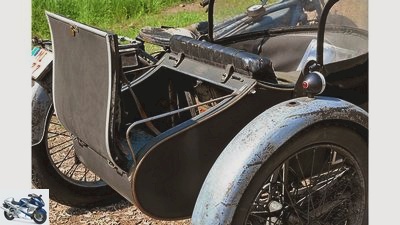
Siemer
26/30
The light boat made of wood and oilcloth offers plenty of space …
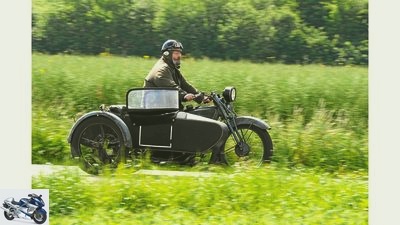
Siemer
27/30
… and even a child seat.
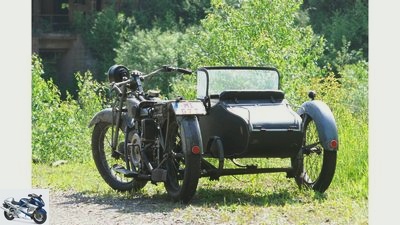
Siemer
28/30
Thanks to its smooth boxer engine, the robust Victoria was considered the ideal tractor.
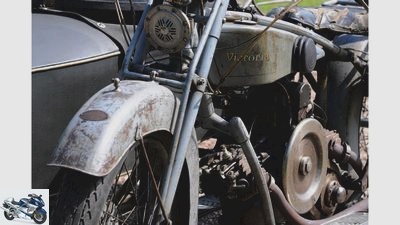
Siemer
29/30
A top product in German mechanical engineering, especially with the 600, which made its debut in the KR VI in 1927.
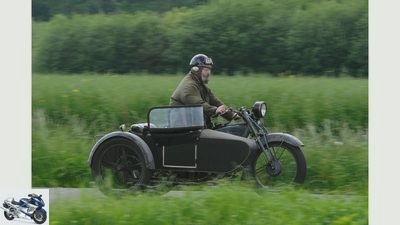
Siemer
30/30
Victoria KR 6 team.
Victoria KR 6 with sidecar
Unrestored original team
Content of
The original paintwork of his Victoria KR 6 team was applied in 1929, and Volker Mollenbeck takes care of its faded, scratched remains with great devotion: he cleans as rarely as possible.
NA motorbike that has aged in honor and for that very reason has been visibly taken along with the right understanding is not everywhere: When a photographer wanted to get a better view at a veterans rally, he quickly got on a team parked next to him. Its condition, it seemed to him, required no special respect. The owner, however, saw it differently, found very energetic words and sent the fleeing photographer afterwards that he should rather climb on A-1 restorations in the future, they could at least be restored to their previous condition. “But that was a long time ago”, laughs Volker Mollenbeck, proud and convinced owner of the said tricycle, “today unrestored originals like my 85-year-old Victoria KR 6 enjoy great recognition.”
Buy complete article
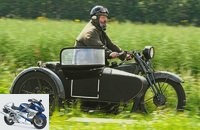
Victoria KR 6 with sidecar
Unrestored original team
Victoria KR 6 was considered the ideal tractor
Thanks to its smooth boxer engine, the robust Victoria KR 6 was considered the ideal tractor. A top product in German mechanical engineering, especially with the 600, which made its debut in the KR VI in 1927. Compared to the previously used half-liter, the bore had grown from 70.5 to 77 millimeters with an unchanged 64 millimeter stroke, and the power increased by six to 18 hp. Worthy of honor, certainly, but in comparison with the corresponding ohv boxers from BMW, the limits of the concept gradually became apparent towards the end of the 1920s: In the Victoria KR 6 engine with a transverse crankshaft, the housing and magnet shadow the rear cylinder the Munich competition are both in the cooling wind. Which was not to be expected, because when BMW man Martin Stolle designed the first motorcycle engine for his employer in 1919, he copied with Chinese audacity, as is well known, the also transversely mounted flat twin of the then much admired English Douglas. The first large-scale buyer of the two-cylinder engine, baptized M 2 B 15, was Victoria from Nuremberg from 1920 onwards. She became rich and important with bicycles, but was also active as a manufacturer of cars and motorcycles before the First World War.
It was very unpleasant that in 1923, immediately after the appearance of the R 32 fitted out by Max Friz with a longitudinally installed boxer and shaft drive, suddenly no more engines were sold to competing manufacturers. Which moved Victoria to hire the clever engineer Stolle, who was divorced in a dispute with Friz. He came with a bag full of new ideas – and his ohv head for the BMW engine, produced by the Munich company Sedlbauer. The Victoria KR (for motorcycle) I with the M 2 B 15 was followed at the end of 1922 by the II with its own drive, initially manufactured by Sedlbauer, and nine instead of 6.5 hp. With the III, a three-speed gearbox moved in from 1924, the output grew – of course – by three hp.
Could be ordered from the factory with a sidecar
Then the 600 KR VI, which was modernized in language in 1928. So that it fit into the grid of the recently added smaller sisters KR 20 (sv single cylinder) and KR 35 (ohv single cylinder, both from Sturmey-Archer), from then on it also used Arabic numerals and was called Victoria KR 6. Drivers – some with JAP engines – are still great successes, and that’s why the Victoria boxer story culminated in a sports version with two carburettors, encapsulated valve trains and 24 hp. At the same time as the triumph in England, Victoria also planned to switch to large parallel two-cylinder engines. Unfortunately, the engines, which were again drawn by Martin Stolle, plagued serious start-up problems, and so the boxers remained in the range until 1936. As was common with many manufacturers at the time, they could be ordered with a sidecar from the factory, and Victoria even had a teardrop-shaped boat ready for the sports driver based on her own victories.
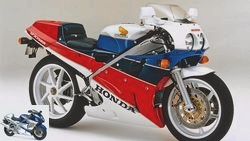
classic
We reveal our absolute classics
The dream classics from MOTORRAD Classic
read more
Spacious touring sidecar on the Victoria KR 6
Volker Mollenbeck is more relaxed, his Victoria KR 6 pulls the spacious touring sidecar. It has a nice entrance door and a respectable luggage compartment under the lid that folds out to the rear, which can also be used as a ride for children. The construction of the convertible top offered by the factory shows a real joke, which when opened acts as a windshield, but when closed rises high above the passenger and then not only allows side views, but also has a small viewing window in the direction of travel. The boat – a wooden construction wrapped in oilcloth and slightly lighter than the sheet metal counterpart that is also offered – rests on a triangular tubular frame, which in turn is held at four points on the motorcycle frame. The sidecar looks elegant and light, thanks in part to the transverse boxer, the entire vehicle is quite narrow. The vehicle documents show an empty weight of 268 kilograms (which is quite high), and that makes the Victoria KR 6 from Volker Mollenbeck astonishingly easy. Your mechanically smoothly running engine must produce well over 18 hp, so easily does it increase speed, so persistently does it advance in the third and last gear of the manual transmission.
“I took it over so quickly”, the qualified engineer for wood and plastic technology rejects any suspicion of tuning and reports of fluctuating performance data for the Victoria KR 6. “That ranges from 18 to 22 hp, with mine I go from a good 20 PS off, the way it runs. ”Well, and it still runs like that today, because inside – unlike the external appearance – parts were sometimes exchanged. When Mollenbeck took over Victoria, it was cleaned extremely gently with petroleum and then partially treated with Ballistol. The engine ran, it actually ran really well, but with an old sweetheart you never know. Completely disassemble. The Mahle company supplied new pistons, those for the heat-sensitive rear cylinder with significantly more clearance. The tappets and pans of the rocker arms required refreshment, and Mollenbeck pressed hollow steel balls into the pans. “Holds up to this day without any problems.” He re-ground the valves and re-centered the oil pump rotor. The crank drive remained untouched “because it looked like new.” A machine fitter manufactured new linings for the optionally hand or foot-operated multi-disc clutch. Victoria’s own gearbox can be a little bit tricky, the sliding blocks of which tend to tilt and then block the waves. So Volker Mollenbeck made new stones and optimized their width.
Victoria suspension fork reliable and comfortable
There was almost no work on the chassis. Re-apply the brakes, insert the spokes where necessary, done. The patented Victoria suspension fork has proven to be as reliable as it is comfortable, in principle a mixture of parallelogram and telescopic fork. At the top, the fork legs have an approximately ten centimeter long slot on the inside into which the ends of the upper cross connection protrude. These act on springs stuck in the bars, one each on tension and one on compression. The horizontal movement of the fork blades is mitigated by small springs in front of and behind the upper cross connection. One of the better forks of its time that also requires little maintenance. The rims have bulbous strips in balloon format. “They were already available on request back then, and the normal format is too weary for me,” explains Mollenbeck, who now and again fetches his Victoria KR 6 out of the garage for short tours. He also attends one or two meetings. “But since many old friends have preferred to stay at home, the number has decreased.” The 67-year-old is easy to talk: Unlike many of his friends, he owns a motorcycle that proves every day how long you can run, even if the paint is almost on is off.
Technical specifications
Engine: Air-cooled two-cylinder four-stroke boxer engine, two valves hanging in the head, operated via tappets, bumpers and rocker arms, bore x stroke 77 x 64 mm, displacement 596 cm³, approx. 18 hp at 3800 rpm, an AMAC carburetor, primary drive via chain , Multi-plate dry clutch, manual Victoria three-speed gearbox, secondary drive via chain.
Landing gear: Hard-soldered tubular steel frame with two beams, Victoria suspension fork at the front, mechanical steering damper, rear wheel unsprung, balloon tires 27 x 3.85 on all three wheels, simplex half-hub brakes at the front and rear.
Related articles
-
Siemer 29 pictures Siemer 1/29 The ideal vehicle for Gerd Windhorst … Siemer 2/29 Siemer 3/29 Siemer 4/29 Siemer 5/29 Siemer 6/29 Siemer 7/29 Siemer …
-
Technical driving report Boxer Team R 1100 S
Technical driving report Boxer Team R 1100 S So must be In 1998 BMW presented the sportiest series boxer of all time. But BMW fan Romolo Liebchen from…
-
KTM Team West 1290 Super Duke R PS-TunerGP 2016
fact 8th photos markus-jahn.com 1/8 Picture gallery, TunerGP: KTM Team West Super Duke R. www.factstudio.de 2/8 What electrifies is this bearish start,…
-
Suzuki V-Strom 1050 Desert Express: Conversion by the Hessler Rally Team
Motorcycle fair in Milan EICMA 2019 Presented by Hessler rally team 10 photos Hessler rally team 1/10 The Hessler Rally Team is making the new V-Strom…
-
Tech Team’s Monkey Garage Honda Z 50 J1 in the driving report
Bilski Tech Team’s Monkey Garage Honda Z 50 J1 in the driving report Snappy squirrel monkey The nice brunette doesn’t know any better: “Oh, she’s cute!”…
-
Indian team with BBQ grill for Sturgis festival
Motorcycle fair in Milan EICMA 2019 Presented by Indian 4th photos Indian 1/4 Indian equipped a Springfield Darkhorse with a sidecar and a fat BBQ grill…
-
Racing team Moto Speed Twin Kit: Retro-Twin with sporty trims
Racing team Moto / Marco Lindenbeck 13 photos Racing team Moto / Marco Lindenbeck 1/13 Rennstall Moto offers a Cafe Racer Kit for the Triumph Speed…
-
BMW R 1200 R in the HP driving report
32 photos 1/32 BMW R 1200 R.. Manufacturer 2/32 BMW R 1200 R.. Manufacturer 3/32 BMW R 1200 R.. 4/32 BMW R 1200…
-
Touratech R 1200 GS Rambler in the driving report
Jan Stárek 19th photos Jan Stárek 1/19 That’s right: ABS that can be easily switched off Jan Stárek 2/19 Touratech is currently developing and testing…
-
Innovations Yamaha Vmax model 2009
Yamaha innovations Yamaha Vmax model 2009 New Yamaha Vmax summer slump? Are you kidding me? Are you serious when you say that. The surprising and anti-cyclical presentation of the new Yamaha Vmax …